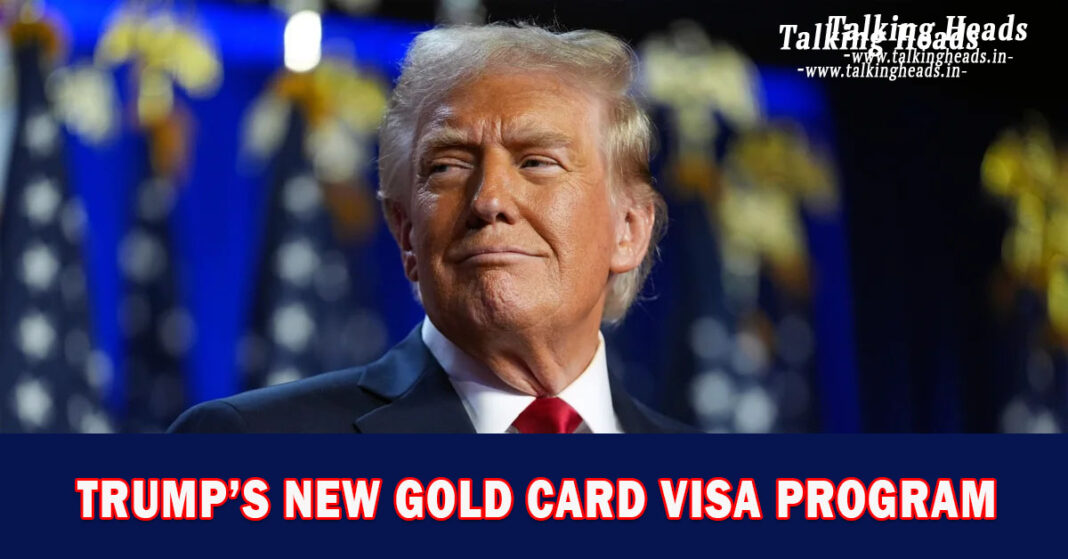Donald Trump introduces the Gold Card Visa Program, offering U.S. citizenship for $5 million. How this new initiative will impact EB-5 and Indian applicants.
Table of Contents
Trump’s $5 Million Gold Card Visa Program: A New Path to U.S. Citizenship
In a groundbreaking announcement , President Donald Trump revealed a new visa program that would allow foreign nationals to obtain U.S. citizenship for a hefty price of $5 million (approximately ₹44 crores). Named the “Gold Card,” this new initiative presents an alternative to the existing EB-5 visa program, which is currently one of the most accessible routes to U.S. citizenship through investment.
The Gold Card is set to be a more exclusive and expensive version of the EB-5 visa, offering a faster path to permanent residency in the U.S. The Trump administration has promised that 10 million Gold Cards will be sold, significantly raising funds to address national debt.
The Gold Card Visa: A Premium Alternative to the EB-5 Program
Trump emphasized that the Gold Card program will open the door to U.S. citizenship, providing holders with a special right akin to the green card. While green cards offer permanent residency, they do not automatically grant citizenship. The new Gold Card will also give the holders similar privileges, including the ability to live and work anywhere in the United States and contribute to the U.S. tax system at a high rate.

The Gold Card’s introduction comes as a significant update to the EB-5 visa program, which has been the primary route for wealthy investors seeking U.S. residency. EB-5 requires a $1 million investment (around ₹8.75 crore), but with the Gold Card program, applicants will have to pay five times that amount. According to Trump, the funds generated from these investments will help reduce national debt while attracting high-level investors to the U.S.
What Does the Gold Card Program Offer?
The Gold Card program promises numerous benefits for its holders. Besides offering a direct path to U.S. citizenship, it will allow investors and their families to bypass many of the bureaucratic hurdles associated with the current immigration system.
This visa will grant similar rights to those of green card holders, including permanent residency, the ability to work, and the right to invest and grow businesses within the U.S. The program will be officially launched in about two weeks, with further details expected soon.
Breaking Away from the 35-Year-Old Immigration System
The Gold Card visa program is a significant departure from the traditional U.S. immigration system, particularly the EB-5 visa program, which has been in effect since 1990. The EB-5 visa is primarily designed to attract foreign investment to create jobs in the U.S.
However, many see the new Gold Card as a premium, streamlined version of the EB-5 visa. While EB-5 requires applicants to invest in a business and create jobs, the Gold Card will likely offer a faster and more straightforward route to citizenship, making it more attractive to those who can afford the higher price tag.
The Impact on Indian Immigrants and Applicants
One of the groups most affected by the Gold Card visa program is Indian nationals. India has long been one of the top countries whose citizens apply for U.S. residency through the EB-5 program. However, the new Gold Card initiative, with its steep price of $5 million, may push the goal of American citizenship further out of reach for many aspiring Indian immigrants.
Additionally, the cancellation of the EB-5 visa program could negatively impact skilled Indian professionals who have been stuck in long green card backlogs. Many of these professionals rely on the EB-5 program to bypass lengthy waiting periods in employment-based green card categories. The introduction of the Gold Card visa could exacerbate these challenges, as it may only be affordable to a limited number of applicants.
What’s Next for U.S. Immigration?
The Gold Card visa is poised to change the landscape of U.S. immigration, particularly for wealthy investors seeking citizenship. While it could offer a faster route to citizenship, the higher cost may exclude many individuals who have relied on the more affordable EB-5 program. Moreover, Indian applicants, who are already facing significant backlogs and long waiting periods, may find this new program out of reach unless the administration introduces reforms to accommodate the growing demand.

It remains to be seen how the Gold Card visa program will impact the broader immigration system. As President Trump pushes forward with this plan, many are questioning whether it will truly benefit the U.S. economy or deepen inequalities within the immigration system. In the coming weeks, more information will be made available as the program moves closer to launch.
The Trump administration’s Gold Card visa program presents a new avenue for obtaining U.S. citizenship, albeit at a much higher price than its predecessor, the EB-5 visa. While this may be an appealing option for wealthy investors, it could significantly affect Indian immigrants who have long relied on the EB-5 program as a route to permanent residency. As the details of the program continue to unfold, the broader effects on U.S. immigration policy and its global appeal will become clearer.










